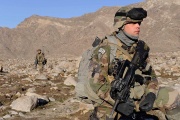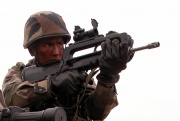FAMAS
| Fusil d'Assaut de la Manufacture d'Armes de Saint-Étienne | |
|---|---|

| |
| FAMAS F1 | |
|
| |
| Type | Bullpup assault rifle |
| Land of Origin | France |
| Specifications | |
| Length | 757mm (29.8 in) / 965mm (38.0 in) with bayonet |
| Barrel length | F1, G2: 488 mm (19.2 in) G2 Commando:405 mm (15.9 in) G2 SMG:320 mm (12.6 in) G2 Sniper 620 mm (24.4 in) |
| Weight | 3.61 kg (7.96 lb) (FAMAS F1) 3.8 kg (8.38 lb) (FAMAS G2) |
| Cartridge | 5.56x45mm NATO |
| Action | Lever-delayed blowback |
|
| |
| Rate of Fire | 900-1000 RPM (F1) 1000-1100 RPM (G2) |
| Muzzle velocity | 960 m/s (3,100 ft/s) (F1) 925 m/s (3,030 ft/s) (G2) |
| Effective Range | 300m (F1); 450m (G2) |
| Max. Range | 3200 metres |
| Feed | 25-round box magazine (F1) 30-round STANAG box magazine (G2) |
| Sights | Rear aperture fitted with tritium night inserts, front post |
| Service History | |
| In service | 1978–present |
| Used by | See Users |
| Wars | |
| Production History | |
| Designer | Paul Tellie |
| Design Date | 1967–1971 |
| Manufacturer | Nexter |
| Unit Cost | F1: €1500 G2: €3000 |
| Produced | 1975–2000 |
| No. Built | F1: 400,000 |
| Variants | F1, G1, G2, FAMAS Export, FAMAS Civil, FAMAS Commando |
Contents |
[edit] History
The first French bullpup rifles were developed between 1946 and 1950 at the AME (Atelier Mécanique de Mulhouse) and MAS, testing rounds such as .30 US Carbine, 7.92x33mm Kurz, 7.65x38mm (Made by Cartoucherie de Valence) and some other intermediate calibers. Since France was engaged in the First Indochina War at the time, and was also the second-largest contributor to NATO, the budgets for new types of weapons were reduced and priority was given to the modernisation and production of existing service weapons. Nevertheless, approximately forty different prototypes were developed between 1952 and 1962, most of which were designed for the 7.62x51mm NATO round, however, the round was not found to be suitable for any bullpup designs, and consequently, none were adopted, and the ideas were set aside. MAS then began to manufacture under licence the H&K G3 and the H&K 33 in the 1960s and studies were reactivated to produce a weapon using the new .223/5.56mm round.
The FAMAS project began in 1967 under the direction of Paul Tellie and the first prototype was completed in 1971,with French military evaluation of the rifle beginning in 1972. When production problems delayed the general issue of the new rifles, and with the 1976 Battle of Kolwezi showing the immediate need for a more modern weapon, the French Army began searching for a temporary rifle to fill this need until the FAMAS came into full production. The H&K 33 was considered, and 1200 pieces were tested by Infantry, Marines, Mechanised and Airborne troops, but it was ultimately turned down in favour of the SIG SG 540, built under licence by Manurhin, until enough FAMAS rifles were produced to begin general issue. The French military finally accepted the rifle in 1978 as the standard French combat weapon.
After adoption, the FAMAS F1 replaced the aging MAS 49/56 rifle and MAT-49 submachine gun, and approximately 400,000 FAMAS F1 assault rifles were produced, with production now complete. The F1 was followed by the G1 that included several minor improvements such as redesigned grips, Magwell compatible with STANAG & FAMAS magazine and an enlarged trigger guard, but it remained conceptual and was never actually produced.
[edit] FAMAS G2
The FAMAS G2 was developed circa 1994 to bring the rifle more in compliance with NATO standards by having tighter rifling and accepting standard NATO magazines, but also included several other upgrades taken from the G1 model, such as the enlarged trigger guard and improved hand guards made of fiber glass, rather than plastics like on the F1. The French Navy purchased the FAMAS G2 in 1995, and began distributing it to the Fusiliers Marins and Commandos Marine, but the French Army has held off large scale purchase of the G2 to date, and the FAMAS F1 still remains the Army's primary service rifle.
[edit] MAS .223
During the late 1980's, Century Arms imported a very small number of semi-automatic FAMAS' into the United States. However due to poor sales, production and importation ceased and the existing number are not only extremely rare but cost in the range of $8,000 with no spare parts available on the market.
[edit] FAMAS Infanterie
The FAMAS Infanterie is an improvement of the FAMAS F1, obtained by retrofiting an accessory rail onto the top of the handguard. This allows mounting combat optics, most notably reflex sights or the 4x magnification SCROME J4 scope.
[edit] Design details
[edit] Action
The FAMAS assault rifle is a bullpup configuration, with the ammunition feed behind the trigger. The receiver housing is made of a special steel alloy, and the rifle furniture is made of fiberglass. The rifle uses a lever-delayed blowback action, a system employed on the LMG AA52 derived from the prototypes built during Army Technical Department tests having taken place between the First and Second World Wars.
[edit] Ergonomy
Fire mode is controlled by a selector within the trigger guard, with three settings: safe (central position), single shot (to the right), and automatic fire (to the left). Automatic fire can be in three-shot bursts (rafale) or fully automatic; this is determined by another selector, located under the housing and behind the magazine.
The FAMAS G2 weighs 3.8 kg (8.38 lb). The G1 and G2 have a large, grip-length trigger guard like a Steyr AUG to allow easy access to the trigger when wearing gloves.
Both F1 and G2 models of the FAMAS feature a bipod attached to the upper hand guard.
The FAMAS-G2 and some F1 sport a "polyvalent handguard" which features a standard NATO accessory rail, allowing a variety of sights to be mounted, notably red dot sights and night vision units.
The FAMAS features two alidades for aiming rifle grenades with several modes:
- direct fire at 75 or 100 metres, in anti-vehicle role
- indirect fire, in anti-personnal role:
- with the FAMAS inclined by 45°, allowing fire from 120 to 340 metres
- with the FAMAS inclined by 74°, allowing fire from 60 to 170 metres
[edit] Ammunition

The FAMAS F1 and G1, the original variants, were designed to use French-made 25-round magazines with 5.56x45mm cartridges. Due to the 1/12 rifling of the F1 barrel and its blowback action, ammunition must be a steel-case, French-made SS109 cartridge; using standard brass-case 5.56x45mm NATO causes overpressure and can cause malfunction. [3] The barrel of the G2 uses a 1/9 rifling, which enables it to use the SS109 or the M193 indifferently.
During training with blank ammunition, a plug is added to the muzzle of the FAMAS. This plug is necessary for automatic or semi-automatic operation, which it allows by blocking part of the gas.
The FAMAS can use a variety of rifle grenades up to 500 grammes. Notable examples are the antipersonal APAV40 and the antitank AC58. It can also fire some hand grenades designed for this alternative purpose, notably the F2 grenade that includes a bullet trap. The FAMAS can accommodate an external grenade launcher as an add-on module under the hand guard; the US M203 grenade launcher is sometimes used.
[edit] Service

The FAMAS first saw service in Chad during Operation Manta and again in desert operations in Kuwait during Operation Desert Storm and in other various peacekeeping missions. Operational conditions proved the weapon to be reliable and trustworthy under combat conditions. The FAMAS is affectionately known as le Clairon ("the Bugle") because of its shape by French-speaking troops. An improved version of the FAMAS G2 is integrated in the Félin system.
Senegal and the United Arab Emirates received a small number of FAMAS F1 rifles from France,[4] though it was unknown when they received them. Djibouti uses this weapon in its military as the standard infantry weapon. The Philippines also received a limited number and is used by the Philippine National Police Special Action Force.[5]
[edit] Users
- Djibouti[6]
- France: Used by the French Armed Forces since 1979, with over 700,000 rifles purchased.[2] Also used by several law enforcement agencies such as the Gendarmerie Nationale.[2]
- Gabon[4]
- Indonesia: Komando Pasukan Katak (Kopaska) tactical diver group and Komando Pasukan Khusus (Kopassus) special forces group.[7]
- Lebanon[6]
- Philippines[5]
- Senegal[4]
- United Arab Emirates[1]
[edit] Resources
| Gun Owners' Resource has the following relevant documents available for free download for the FAMAS and/or its variants: |
- GIAT Mas .223 semi-auto FAMAS variant operator's manual (30 pgs, 4.1 MB)

This article is either missing some diagrams which would help to illustrate a proper breakdown of the firearm in question or the diagrams which are here are inadequate. This article could use more input to fill in the missing bits. You (yes, you!) can help Gunsopedia provide more comprehensive information to our users by using your own knowledge to add to it.
[edit] External links
- Official Nexter FAMAS page
- FELIN article, with FAMAS pictured as part of FELIN system
- Modern Firearms
- REMTEK
[edit] Sources and references
- ↑ 1.0 1.1 1.2 Bishop, Chris. Guns in Combat. Chartwell Books, Inc (1998). ISBN 0-7858-0844-2.
- ↑ 2.0 2.1 2.2 Marchington, James (2004). The Encyclopedia of Handheld Weapons. Lewis International, Inc. ISBN 1-930983-14-X.
- ↑ L'armée rencontre de sérieuses difficultés avec les munitions du fusil Famas
- ↑ 4.0 4.1 4.2 Armada International, Assault rifles in a 5.56 mm evolution: the fielding of new designs and the upgrade of existing weapons will ensure that 5.56 mm remains the predominant assault rifle calibre April-May 2007
- ↑ 5.0 5.1 Famas F-1, Rifles n Guns, 2007-01-02
- ↑ 6.0 6.1 Jones, Richard D. Jane's Infantry Weapons 2009/2010. Jane's Information Group; 35 edition (January 27, 2009). ISBN 978-0710628695.
- ↑ Kopassus & Kopaska - Specijalne Postrojbe Republike Indonezije Hrvatski Vojnik Magazine (Croatian)
| This page is part of a series on: current French infantry weaponry | ||
|---|---|---|
| Handguns | PAMAS· MAC Mle 1950 | |
| Rifles | Assault rifles | FAMAS · SIG SG 550 (and variants) · HK 416 |
| Anti-materiel rifle | PGM Hecate II | |
| Sniper | FR F2 · FR F1 | |
| Shotguns | Benelli M4 | |
| Submachine guns | MP5 · P90 | |
| Machine guns | M2HB · AA52 · Minimi | |
| Grenade launchers | M203 · LGI | |
| Mortars | LLR 81mm · MO-120-RT-61 | |
| Rockets | LRAC F1 · ABL | |
| Missiles | MILAN · ERYX · Mistral | |
| Cartridges | 12-gauge · 5.7x28mm · 9x19mm NATO · 5.56x45mm NATO · 7.62x51mm NATO · 12.7x99mm NATO | |



